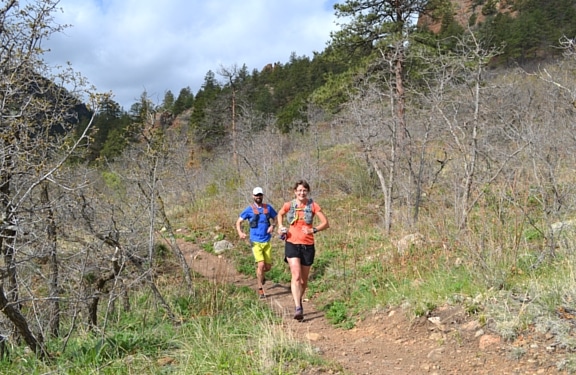
Should You Include Downhill Repeats in Your Ultrarunning Training?
Excerpt from Jason Koop’s Training Essentials for Ultrarunning
Downhill running is important in ultrarunning. As the old adage goes: What goes up must come down. Add to that the fact that between uphill and downhill running, downhill is much sexier. Go ahead, check out YouTube and gawk at the Salomon videos of young, fearless athletes bombing down ridiculously steep, off-trail, technical terrain at preposterously high velocities. It is tempting to lace up some body armor, point downhill and let it fly. From a purely practical standpoint, there are two fundamental aspects to improving your downhill running prowess in an ultramarathon setting. The first is the speed you can run downhill; the second (which is more important to ultrarunning) is repeatability. Can you run downhill at the same speed mile after mile? You can improve both of these things, but before jumping in headfirst and barreling down the next descent, consider how much of an impact this has in making you a better ultrarunner.
[blog_promo promo_categories=”coaching” ids=”” /]Many coaches and athletes advocate specific downhill and quad-banging sessions to properly prepare for downhill running. Others emphasize strength training to “season” the quads. I dislike both of these approaches, and I don’t advocate either one of them. Make no mistake: You can become a better and more consistent downhill runner if you do specific, hard downhill sessions. But these improvements come at too high a cost, and you are sacrificing one benefit for another. Yes, your quads might improve. You might become a faster down-hill runner. You might be able to better tolerate more vertical feet of descending. But you do so at the expense of improving something else, namely, your cardio-vascular fitness.
[blog_promo promo_categories=”bucket list” ids=”” /]I will always take 1 percent improvement on the ups (related to cardiovascular fitness) versus 1 percent improvement on the downs. Why? Simple math. In any ultramarathon race you are going uphill for a far greater proportion of time than you are going downhill. Sometimes, the ratio is as much as 2 to 1. You will gain more time by being a faster climber than you will gain being faster downhill. Or, put another way, even with training, you don’t descend fast enough to overcome the time you lose by going slower uphill. Add to that the fact that the risk of injury, both acute and overuse, is far greater from high-velocity downhill running than from uphill running. Yes, you should practice downhill running, but not at the expense of improving climbing performance and certainly not to the extent that you are doing specific downhill sessions.
For a limited time, you can get a free copy of Koop’s Training Essentials for Ultrarunning when you sign up for a CTS Coaching Package.
View Ultrarunning Coaching Offer
Feel Stronger in 6 Weeks — No Matter Your Age
Climbs feel steeper? Recovery slower?
You’re not done getting faster — you just need a smarter plan.
The 6-Week Masters Power Build Coaching Program is designed for cyclists 50+ who want to boost power, recover faster, and ride stronger — all with expert 1:1 coaching.
- Personalized 6-Week Training Plan
- 1:1 Coaching + TrainingPeaks Premium
- Mobility & Strength Bonus Guides
💪 Guarantee: Stronger or free.
Start your 6-week journey for $149► Free Cycling Training Assessment Quiz
Take our free 2-minute quiz to discover how effective your training is and get recommendations for how you can improve.
► FREE Mini-Course: Learn How to Maximize Your Limited Training Time
Learn step-by-step how to overcome limited training time and get faster. Walk away with a personalized plan to increase your performance.
"*" indicates required fields


Comments 2
I subscribe to the newsletter but my web security and google-chrome blocked access – red alert on the IP. Obviously it’s not your site (got here directly through Facebook) but all the web tracking garbage that gets attached to my personalized link from the newsletter. It’s not the first time your site has been indirectly blocked. Everything failed even the signup to Summer Coaching. ($)
Am I the only one missing Chris’s insightful commentary on the Tour this year? Ward Beaudry